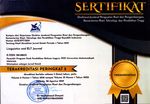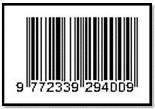Forensic Stylistic Analysis of UNNES Student’s Suicide Note
Abstract
Keywords
Full Text:
PDFReferences
Banikalef, A. A. (2021). How do Jordanians express their birthday wishes on Facebook? A sociolinguistic study. In Journal of Language and Linguistic Studies (Vol. 17). https://doi.org/10.17263/jlls.904052
Bloor, M., & Bloor, T. (1986). Languages for Specific Purposes: Practice and Theory. Trinity College Dublin Centre for Language and Communication Studies.
Chaski, C. E. (2012). Is this a real suicide note? Authentication using statistical classifiers and computational linguistics. In Paper presented at the 64th Annual Meeting of the Academy of Forensic Sciences. Global Research: The Forensic Science Edge.
Crystal, D. (1987). The Cambridge Encyclopedia of Language. Cambridge University Press.
Eber-Schmid, B. J. (2017). Digitalpulse. Women’s Voices Magazine.
Fata, I. A., Yusuf, Y. Q., Kamal, R., & Namaziandost, E. (2021). The characteristics of linguistic features enfolded in suicide notes. Journal of Language and Linguistic Studies, 17(2). https://doi.org/10.52462/jlls.50
Galasinki. (2017). Discourses of Men’s Suicide Notes : A Qualitative Analysis. In Discourses of Men’s Suicide Notes : A Qualitative Analysis. https://doi.org/10.5040/9781350005761
Hassouneh, I., & Zibin, A. (2021). Analysis of complaining strategies on services offered to Facebook users on Zain Jordan. Journal of Language and Linguistic Studies, 17. https://doi.org/10.17263/jlls.904138
Ioannou, M., & Debowska, A. (2014). Genuine and simulated suicide notes: An analysis of content. Forensic Science International, 245. https://doi.org/10.1016/j.forsciint.2014.10.035
Leech, G. N. (2014). A Linguistic Guide to English Poetry. In A Linguistic Guide to English Poetry. https://doi.org/10.4324/9781315836034
Maharani, S., Rangkuti, R., & Manugeren. (2022). The Qualities of Forensic Stylistics enfolded in Suicide Notes. Bahas, 33(1).
Olsson, J. (2004). Forensic Linguistics: An Introduction to Language, Crime and the Law. Continuum Intl Pub Group.
Olsson, J. (2008). Forensic Linguistics: Second Edition. In Continuum International Publishing Group.
Prokofyeva, T. (2013). Language use in two types of suicide texts [Master’s Thesis, Linköping University]. https://www.diva-portal.org/smash/record.jsf?pid=diva2%3A668437&dswid=-4788
Rani, M., Girdhar, S., & Murty, O. P. (2015). Suicide note: The last words. Journal of Forensic Medicine and Toxicology, 32(2).
Schoene, A. M., & Dethlefs, N. (2016). Automatic identification of suicide notes from linguistic and sentiment features. Proceedings of the Annual Meeting of the Association for Computational Linguistics. https://doi.org/10.18653/v1/w16-2116
Shapero, J. J. (2011). The language of suicide notes [Thesis, University of Birmingham]. https://etheses.bham.ac.uk//id/eprint/1525/1/Shapero11PhD.pdf
Simpson, P. (2004). Stylistics, a resource book for students. Routledge. https://books.google.co.id/books?id=21-aRiC9sZkC&lpg=PP14&ots=yWDVM5dwXH&dq=Stylistics%2C%20a%20resource%20book%20for%20students&lr&pg=PP14#v=onepage&q=Stylistics,%20a%20resource%20book%20for%20students&f=false
Sudjana, E. T. S., & Fitri, N. (2013). Kurt Cobain ’ s Suicide Note Case : Forensic Linguistic Profiling Analysis. International Journal of Criminology and Sociology, 6(4).
Trask, R. L. (2007). Language and Linguistics: The Key Concepts. In Language and Linguistics: The Key Concepts. https://doi.org/10.4324/9780203961131
Umiyati, M. (2020). A Literature Review of Forensic Linguistics. IJFL (International Journal of Forensic Linguisti, 1(1).
Wales, K. (2014). A Dictionary of Stylistics. In A Dictionary of Stylistics. https://doi.org/10.4324/9781315833507
DOI: https://doi.org/10.31764/leltj.v11i2.19965
Refbacks
- There are currently no refbacks.
Copyright (c) 2023 Dini Eka Maulida, Missy Ayu Andira, Reggina Onggatta, Shafiah Balqis, Syifa Fitri Hamzah, Rahmadsyah Rangkuti

This work is licensed under a Creative Commons Attribution-ShareAlike 4.0 International License.
_____________________________________________________
Linguistics and ELT Journal
p-ISSN 2339-2940 | e-ISSN 2614-8633

LELTJ is licensed under a Creative Commons Attribution-ShareAlike 4.0 International License.
_____________________________________________________
LELTJ is abstracting & indexing in the following databases:
_____________________________________________________
LELTJ Editorial Office:













